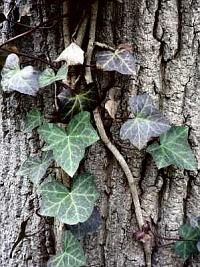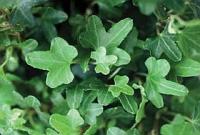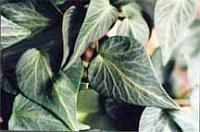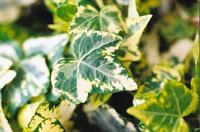

is Harmful
Acknowledgements
ENGLISH IVY
Hedera helix
Hedera is the Latin word for ivy;
helix means winding around.



Identification
Look-Alikes
Why English Ivy
is Harmful Removing English Ivy
Notes of Interest
References &
Acknowledgements |
ENGLISH IVY
|

|
In general the farther downstream one travels, toward older settlement, the more one finds established ivy. In Kemp Mill above University Blvd there is only one small colony of ivy known. Between the Park Headquarters and Colesville Road nearly every tree, at least fifty, on the west wide is laden with ivy which has run downhill from back yards on Dale. One sees progressively more ivy on trees driving down the Parkway, until shortly before New Hampshire ivy coverage is 100%.
Ivy occurs naturally in Europe, Asia to the Caucasus Mountains, and in northern Africa. Ireland is considered to have a separate species. (Univ. of Minnesota website)
Ivy is now "a common, naturalized plant in Australia, New Zealand, Hawaii, Brazil and North America" (Laroque, 1998, in Univ. of Minn. website). It is prevalent in eastern US, and to Easterners an incredibly serious problem in northwestern US. t is supposed English ivy was brought here by the European colonists. A specific reference was evidently found by the No-Ivy League, which reports ivy was "introduced to North America in 1797."
One hears strange reports of ivy that grows on trees long after the leaves should have turned brown. It has been suggested that a stem of ivy probably went uncut because it was hidden behind bark. Please report such a situation, and consider taking a photo. Ivy leaves need several weeks to brown.
A positive word for English ivy in its native Europe was published by researcher Fernley-Whittingstall in 1992, described on the University of Minnesota website. "English ivy benefits a forest community by protecting the woodland floor from frost, supporting trees structurally, and providing a winter food source for ground foraging birds and mammals, such as starlings (Sturnus vulgaris) and elk (Cervus elaphus)." Two years later Wyman (1994) wrote that in certain areas of its native zone, Hedera helix is considered to be very weedy, an aggressive vine that virtually smothers most seedlings, breaks tree branches, and accelerates the death of trees. A third writer said in 1995, "the disagreement of the character and impact of H. helix has resulted in considerable debate regarding the destructive nature of ivy in its native habitat. (Elliott, 1995)."
Over 400 varieties have been characterized by the American Ivy Society. The three below were named Varieties of the Year. Some types prefer slightly different living conditions from others.
Duck Foot, Teardrop, and Golden Ingot, Varieties of the Year in 2002, 2003, and 2004.



English Ivy belongs to the ginseng family, Araliaceae.
A plant in England is known to be over 400 years old.
In Washington and Oregon, where English ivy has taken hold even more than here, new vines grow atop old vines. The old vines form an "ivy desert," a thick blanket through which absolutely nothing grows.